NumPy生成0到1之间随机数的全面指南
参考:numpy random number between 0 and 1
NumPy是Python中用于科学计算的核心库之一,其中的随机数生成功能非常强大和灵活。本文将详细介绍如何使用NumPy生成0到1之间的随机数,包括各种分布类型、生成方法以及实际应用场景。
1. NumPy随机数基础
在开始生成0到1之间的随机数之前,我们需要了解NumPy随机数模块的基础知识。
1.1 导入NumPy和随机数模块
首先,我们需要导入NumPy库和其随机数模块:
import numpy as np
from numpy import random
这样,我们就可以使用np.random或直接使用random来调用随机数函数了。
1.2 设置随机种子
为了确保结果的可重复性,我们通常会设置一个随机种子:
import numpy as np
from numpy import random
np.random.seed(42)
print("Random seed set for numpyarray.com example")
Output:

设置随机种子后,每次运行代码时生成的随机数序列都会相同,这对于调试和复现结果非常有用。
2. 生成单个0到1之间的随机数
2.1 使用random()函数
最简单的方法是使用random()函数:
import numpy as np
from numpy import random
random_number = np.random.random()
print(f"Random number between 0 and 1 for numpyarray.com: {random_number}")
Output:

这个函数会返回一个[0.0, 1.0)区间内的浮点数。注意,这个区间包含0但不包含1。
2.2 使用rand()函数
rand()函数也可以用来生成0到1之间的随机数:
import numpy as np
from numpy import random
random_number = np.random.rand()
print(f"Random number using rand() for numpyarray.com: {random_number}")
Output:

rand()和random()的主要区别在于rand()可以直接生成多维数组,而random()需要指定shape参数。
3. 生成多个0到1之间的随机数
3.1 使用random()函数生成数组
要生成多个随机数,我们可以给random()函数传递一个shape参数:
import numpy as np
from numpy import random
random_array = np.random.random((3, 4))
print("Random array for numpyarray.com:")
print(random_array)
Output:
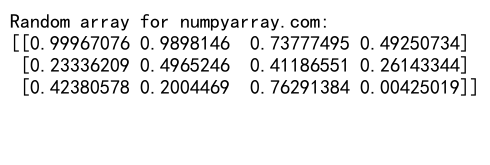
这将生成一个3×4的二维数组,其中每个元素都是0到1之间的随机数。
3.2 使用rand()函数生成数组
同样,rand()函数也可以用来生成多维随机数组:
import numpy as np
from numpy import random
random_array = np.random.rand(2, 3, 4)
print("3D random array for numpyarray.com:")
print(random_array)
Output:
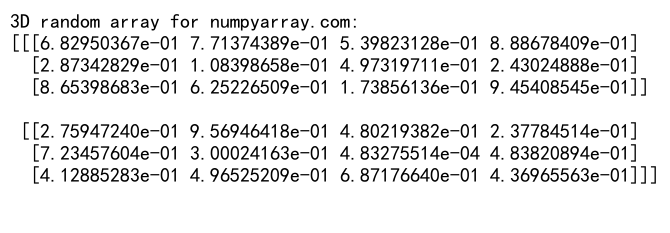
这将生成一个2x3x4的三维数组。
4. 特定分布的随机数
除了均匀分布,NumPy还提供了多种其他分布的随机数生成方法。
4.1 正态分布(高斯分布)
使用normal()函数可以生成正态分布的随机数:
import numpy as np
from numpy import random
normal_random = np.random.normal(loc=0.5, scale=0.1, size=(2, 3))
print("Normal distribution random numbers for numpyarray.com:")
print(normal_random)
Output:

这里,loc是均值,scale是标准差,size是输出数组的形状。
4.2 指数分布
使用exponential()函数可以生成指数分布的随机数:
import numpy as np
from numpy import random
exp_random = np.random.exponential(scale=1.0, size=5)
print("Exponential distribution random numbers for numpyarray.com:")
print(exp_random)
Output:

scale参数控制分布的形状,size指定输出数组的大小。
5. 自定义范围的随机数
有时我们需要在0到1以外的范围内生成随机数。
5.1 使用uniform()函数
uniform()函数允许我们指定随机数的范围:
import numpy as np
from numpy import random
custom_range = np.random.uniform(low=0.5, high=0.8, size=(2, 2))
print("Custom range random numbers for numpyarray.com:")
print(custom_range)
Output:

这将生成一个2×2的数组,其中的数字都在0.5到0.8之间。
5.2 缩放和平移随机数
我们也可以通过缩放和平移0到1之间的随机数来达到同样的效果:
import numpy as np
from numpy import random
scaled_random = np.random.random(5) * 0.3 + 0.5
print("Scaled and shifted random numbers for numpyarray.com:")
print(scaled_random)
Output:

这将生成5个在0.5到0.8之间的随机数。
6. 随机整数
虽然本文主要讨论0到1之间的随机数,但有时我们也需要生成随机整数。
6.1 使用randint()函数
randint()函数可以生成指定范围内的随机整数:
import numpy as np
from numpy import random
random_integers = np.random.randint(low=0, high=10, size=5)
print("Random integers for numpyarray.com:")
print(random_integers)
Output:
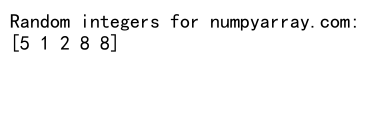
这将生成5个0到9之间的随机整数。
6.2 使用choice()函数
choice()函数可以从给定的序列中随机选择元素:
import numpy as np
from numpy import random
choices = np.random.choice([0, 1], size=10, p=[0.3, 0.7])
print("Random choices for numpyarray.com:")
print(choices)
Output:
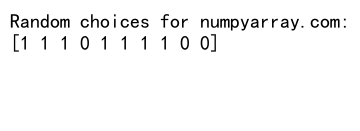
这将从0和1中随机选择10个数,其中选择0的概率为0.3,选择1的概率为0.7。
7. 随机排列和洗牌
NumPy还提供了一些函数来随机排列数组或洗牌。
7.1 使用permutation()函数
permutation()函数可以随机排列一个序列:
import numpy as np
from numpy import random
arr = np.arange(10)
permuted = np.random.permutation(arr)
print("Permuted array for numpyarray.com:")
print(permuted)
Output:
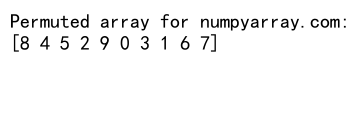
这将随机排列0到9的数字。
7.2 使用shuffle()函数
shuffle()函数可以原地洗牌一个数组:
import numpy as np
from numpy import random
arr = np.arange(10)
np.random.shuffle(arr)
print("Shuffled array for numpyarray.com:")
print(arr)
Output:
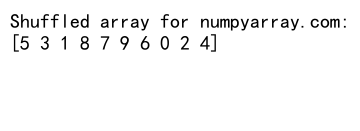
这也会随机排列0到9的数字,但是直接修改原数组。
8. 随机采样
在某些情况下,我们需要从一个大的数据集中随机采样。
8.1 不放回采样
使用choice()函数可以实现不放回采样:
import numpy as np
from numpy import random
population = np.arange(100)
sample = np.random.choice(population, size=10, replace=False)
print("Random sample without replacement for numpyarray.com:")
print(sample)
Output:

这将从0到99中随机选择10个不重复的数字。
8.2 加权采样
我们还可以给每个元素分配不同的权重:
import numpy as np
from numpy import random
population = ['A', 'B', 'C', 'D']
weights = [0.1, 0.2, 0.3, 0.4]
sample = np.random.choice(population, size=5, p=weights)
print("Weighted random sample for numpyarray.com:")
print(sample)
Output:

这将根据给定的权重从A、B、C、D中随机选择5个元素(可重复)。
9. 生成随机矩阵
在某些应用中,我们可能需要生成随机矩阵。
9.1 随机单位矩阵
我们可以使用random()函数和eye()函数组合生成随机单位矩阵:
import numpy as np
from numpy import random
random_identity = np.eye(3) * np.random.random((3, 3))
print("Random identity matrix for numpyarray.com:")
print(random_identity)
Output:
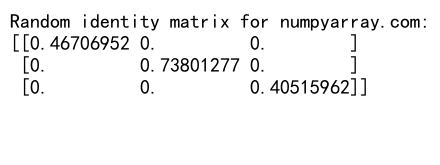
这将生成一个3×3的随机单位矩阵,对角线上的元素是0到1之间的随机数。
9.2 随机对称矩阵
生成随机对称矩阵也是一个常见的需求:
import numpy as np
from numpy import random
random_symmetric = np.random.random((3, 3))
random_symmetric = (random_symmetric + random_symmetric.T) / 2
print("Random symmetric matrix for numpyarray.com:")
print(random_symmetric)
Output:
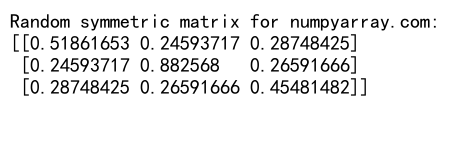
这将生成一个3×3的随机对称矩阵。
10. 应用场景
了解了如何生成0到1之间的随机数后,让我们看看一些实际的应用场景。
10.1 蒙特卡洛模拟
蒙特卡洛模拟是一种广泛使用随机数的技术。例如,我们可以用它来估算π的值:
import numpy as np
from numpy import random
def estimate_pi(n):
points = np.random.random((n, 2))
inside_circle = np.sum(np.sum(points**2, axis=1) <= 1)
pi_estimate = 4 * inside_circle / n
return pi_estimate
print(f"Estimated value of pi for numpyarray.com: {estimate_pi(1000000)}")
Output:

这个函数通过在单位正方形内随机生成点,然后计算落在单位圆内的点的比例来估算π的值。
10.2 随机梯度下降
在机器学习中,随机梯度下降是一种常用的优化算法,它使用随机采样来加速训练过程:
import numpy as np
from numpy import random
def stochastic_gradient_descent(X, y, learning_rate=0.01, epochs=100):
m, n = X.shape
theta = np.zeros(n)
for _ in range(epochs):
i = np.random.randint(0, m)
gradient = (np.dot(X[i], theta) - y[i]) * X[i]
theta -= learning_rate * gradient
return theta
X = np.random.random((100, 3))
y = np.random.random(100)
theta = stochastic_gradient_descent(X, y)
print("Optimized theta for numpyarray.com:")
print(theta)
Output:
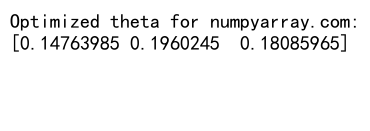
这个简化的随机梯度下降实现展示了如何使用随机采样来优化模型参数。
11. 性能考虑
在使用NumPy生成大量随机数时,性能是一个重要的考虑因素。
11.1 预分配内存
当需要生成大量随机数时,预先分配内存可以提高性能:
import numpy as np
from numpy import random
def generate_random_numbers(n):
result = np.empty(n)
result[:] = np.random.random(n)
return result
random_numbers = generate_random_numbers(1000000)
print(f"Generated {len(random_numbers)} random numbers for numpyarray.com")
Output:

这种方法比直接调用np.random.random(1000000)更高效,尤其是在生成非常大的数组时。
11.2 使用向量化操作
尽可能使用NumPy的向量化操作,而不是Python循环:
import numpy as np
from numpy import random
def apply_random_threshold(arr, threshold=0.5):
random_mask = np.random.random(arr.shape) > threshold
return arr * random_mask
input_array = np.arange(10)
result = apply_random_threshold(input_array)
print("Result of random thresholding for numpyarray.com:")
print(result)
Output:

这个函数使用随机阈值来过滤数组元素,完全使用NumPy的向量化操作,避免了Python循环。
12. 随机数生成器的状态
了解和控制随机数生成器的状态对于reproducibility和调试非常重要。
12.1 获取和设置状态
我们可以获取当前的随机数生成器状态,并在之后恢复它:
import numpy as np
from numpy import random
# Save the state
state = np.random.get_state()
# Generate some random numbers
print("Random numbers for numpyarray.com before restoring state:")
print(np.random.random(3))
# Restore the state
np.random.set_state(state)
# Generate the same random numbers again
print("Random numbers for numpyarray.com after restoring state:")
print(np.random.random(3))
Output:

这个例子展示了如何保存和恢复随机数生成器的状态,以重现相同的随机数序列。
12.2 使用不同的随机数生成器
NumPy提供了多种随机数生成器,我们可以根据需要选择不同的生成器:
from numpy.random import PCG64, Generator
import numpy as np
from numpy import random
rng = Generator(PCG64())
print("Random numbers using PCG64 for numpyarray.com:")
print(rng.random(3))
Output:

这个例子使用了PCG64随机数生成器,它提供了更好的统计性质和更长的周期。
13. 高级技巧
最后,让我们看一些更高级的随机数生成技巧。
13.1 生成具有特定相关性的随机数
有时我们需要生成具有特定相关性的随机数:
import numpy as np
from numpy import random
def correlated_random(size, correlation):
x = np.random.normal(0, 1, size)
y = correlation * x + np.sqrt(1 - correlation**2) * np.random.normal(0, 1, size)
return x, y
x, y = correlated_random(1000, 0.7)
print(f"Correlation for numpyarray.com: {np.corrcoef(x, y)[0, 1]}")
Output:

这个函数生成两组具有指定相关系数的随机的随机数。
13.2 生成非均匀分布的随机数
有时我们需要生成符合特定非均匀分布的随机数。例如,我们可以使用逆变换采样方法:
import numpy as np
from numpy import random
def custom_distribution(size):
u = np.random.random(size)
return np.sqrt(-2 * np.log(1 - u))
samples = custom_distribution(1000)
print(f"Custom distribution samples for numpyarray.com: {samples[:5]}")
Output:

这个例子生成了符合 f(x) = x * exp(-x^2/2) 分布的随机数。
14. 随机数在科学计算中的应用
随机数在科学计算中有广泛的应用,从模拟物理系统到优化算法。
14.1 布朗运动模拟
我们可以使用随机数来模拟布朗运动:
import numpy as np
from numpy import random
def brownian_motion(n_steps, dt=0.1):
random_steps = np.random.normal(0, np.sqrt(dt), (n_steps, 2))
return np.cumsum(random_steps, axis=0)
trajectory = brownian_motion(1000)
print(f"Brownian motion end point for numpyarray.com: {trajectory[-1]}")
Output:

这个函数模拟了二维平面上的布朗运动轨迹。
14.2 随机森林特征重要性
在机器学习中,随机森林算法经常使用随机采样来评估特征重要性:
import numpy as np
from numpy import random
def random_forest_feature_importance(X, y, n_estimators=100):
n_features = X.shape[1]
feature_importance = np.zeros(n_features)
for _ in range(n_estimators):
feature_subset = np.random.choice(n_features, size=int(np.sqrt(n_features)), replace=False)
X_subset = X[:, feature_subset]
importance = np.random.random(len(feature_subset)) # Simplified importance calculation
feature_importance[feature_subset] += importance
return feature_importance / n_estimators
X = np.random.random((100, 10))
y = np.random.random(100)
importance = random_forest_feature_importance(X, y)
print(f"Feature importance for numpyarray.com: {importance}")
Output:

这是一个简化的随机森林特征重要性计算示例,展示了如何使用随机采样来评估特征。
15. 随机数在密码学中的应用
虽然NumPy的随机数生成器不应该用于密码学目的,但了解随机数在密码学中的重要性是有益的。
15.1 生成随机密钥
以下是一个生成随机密钥的简单示例(注意:这只是一个演示,不应在实际的密码系统中使用):
import numpy as np
from numpy import random
def generate_random_key(length=32):
return np.random.bytes(length)
random_key = generate_random_key()
print(f"Random key for numpyarray.com: {random_key.hex()}")
Output:

这个函数生成一个指定长度的随机字节序列,可以用作简单的密钥。
15.2 简单的随机置换密码
我们可以使用NumPy的随机排列功能来实现一个简单的置换密码:
import numpy as np
from numpy import random
def simple_permutation_cipher(text):
chars = np.array(list(text))
permutation = np.random.permutation(len(chars))
encrypted = chars[permutation]
return ''.join(encrypted), permutation
message = "Hello, numpyarray.com!"
encrypted, key = simple_permutation_cipher(message)
print(f"Encrypted message: {encrypted}")
print(f"Encryption key: {key}")
Output:

这个函数对输入文本进行随机置换,并返回加密后的文本和置换密钥。
16. 随机数在游戏开发中的应用
随机数在游戏开发中也有广泛的应用,从生成随机地图到控制NPC行为。
16.1 生成随机地图
以下是一个简单的随机地图生成器示例:
import numpy as np
from numpy import random
def generate_random_map(width, height, obstacle_prob=0.3):
return np.random.random((height, width)) > obstacle_prob
random_map = generate_random_map(10, 10)
print("Random map for numpyarray.com:")
print(random_map.astype(int))
Output:
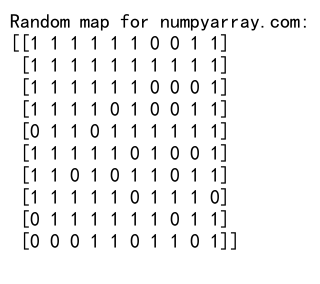
这个函数生成一个二维数组表示的随机地图,其中True表示可通过的区域,False表示障碍物。
16.2 随机物品掉落
在游戏中,我们经常需要实现随机物品掉落机制:
import numpy as np
from numpy import random
def random_item_drop(items, probabilities):
return np.random.choice(items, p=probabilities)
items = ['Sword', 'Shield', 'Potion', 'Gold']
probabilities = [0.1, 0.2, 0.3, 0.4]
dropped_item = random_item_drop(items, probabilities)
print(f"Dropped item for numpyarray.com: {dropped_item}")
Output:

这个函数根据给定的概率分布随机选择一个物品。
17. 随机数在金融模型中的应用
随机数在金融建模中扮演着重要角色,特别是在风险分析和资产定价中。
17.1 蒙特卡洛期权定价
以下是一个简化的蒙特卡洛方法对欧式看涨期权定价的示例:
import numpy as np
from numpy import random
def monte_carlo_option_pricing(S0, K, T, r, sigma, n_simulations):
z = np.random.normal(0, 1, n_simulations)
ST = S0 * np.exp((r - 0.5 * sigma**2) * T + sigma * np.sqrt(T) * z)
payoffs = np.maximum(ST - K, 0)
option_price = np.exp(-r * T) * np.mean(payoffs)
return option_price
S0, K, T, r, sigma = 100, 100, 1, 0.05, 0.2
price = monte_carlo_option_pricing(S0, K, T, r, sigma, 100000)
print(f"Option price for numpyarray.com: {price:.2f}")
Output:

这个函数使用蒙特卡洛模拟来估算欧式看涨期权的价格。
17.2 投资组合风险分析
我们可以使用随机数来模拟投资组合的潜在回报:
import numpy as np
from numpy import random
def portfolio_risk_analysis(returns, weights, n_simulations):
portfolio_returns = np.random.multivariate_normal(returns, np.eye(len(returns)), n_simulations)
weighted_returns = np.dot(portfolio_returns, weights)
return np.mean(weighted_returns), np.std(weighted_returns)
returns = np.array([0.05, 0.1, 0.15])
weights = np.array([0.3, 0.4, 0.3])
mean_return, std_return = portfolio_risk_analysis(returns, weights, 10000)
print(f"Portfolio mean return for numpyarray.com: {mean_return:.2f}")
print(f"Portfolio standard deviation for numpyarray.com: {std_return:.2f}")
Output:

这个函数模拟了投资组合的潜在回报,并计算了平均回报和标准差。
结论
NumPy提供了强大而灵活的工具来生成0到1之间的随机数,以及其他各种分布的随机数。这些工具在科学计算、机器学习、金融建模、游戏开发等众多领域都有广泛的应用。通过本文的详细介绍和丰富的示例,我们不仅学习了如何生成各种随机数,还探讨了它们在实际应用中的使用方法。
随机数生成是一个深奥而有趣的主题,本文仅仅触及了表面。在实际应用中,我们还需要考虑更多因素,如随机数的质量、生成速度、可重复性等。同时,对于一些特殊的应用场景,如密码学,我们需要使用专门的密码学安全随机数生成器。
 极客教程
极客教程